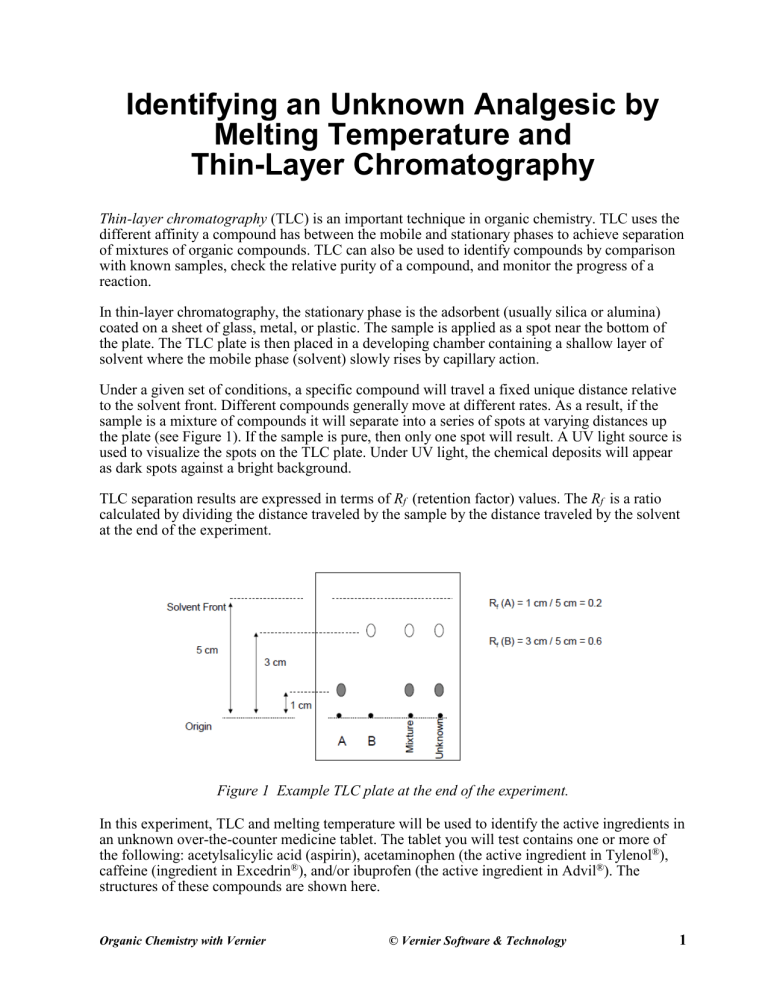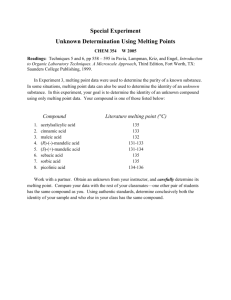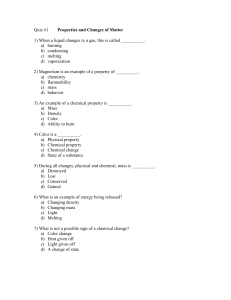04-Identifying an Unknown Analgesic by Melting

Identifying an Unknown Analgesic by
Melting Temperature and
Thin-Layer Chromatography
Thin-layer chromatography (TLC) is an important technique in organic chemistry. TLC uses the different affinity a compound has between the mobile and stationary phases to achieve separation of mixtures of organic compounds. TLC can also be used to identify compounds by comparison with known samples, check the relative purity of a compound, and monitor the progress of a reaction.
In thin-layer chromatography, the stationary phase is the adsorbent (usually silica or alumina) coated on a sheet of glass, metal, or plastic. The sample is applied as a spot near the bottom of the plate. The TLC plate is then placed in a developing chamber containing a shallow layer of solvent where the mobile phase (solvent) slowly rises by capillary action.
Under a given set of conditions, a specific compound will travel a fixed unique distance relative to the solvent front. Different compounds generally move at different rates. As a result, if the sample is a mixture of compounds it will separate into a series of spots at varying distances up the plate (see Figure 1). If the sample is pure, then only one spot will result. A UV light source is used to visualize the spots on the TLC plate. Under UV light, the chemical deposits will appear as dark spots against a bright background.
TLC separation results are expressed in terms of R f
(retention factor) values. The R f
is a ratio calculated by dividing the distance traveled by the sample by the distance traveled by the solvent at the end of the experiment.
Figure 1 Example TLC plate at the end of the experiment.
In this experiment, TLC and melting temperature will be used to identify the active ingredients in an unknown over-the-counter medicine tablet. The tablet you will test contains one or more of the following: acetylsalicylic acid (aspirin), acetaminophen (the active ingredient in Tylenol
®
), caffeine (ingredient in Excedrin
®
), and/or ibuprofen (the active ingredient in Advil
®
). The structures of these compounds are shown here.
Organic Chemistry with Vernier © Vernier Software & Technology 1
O
H
3
C
O
OH
H N CH
3
O
CH
3
H O O
H
3
C
N
N
O O
O N
N
H
3
C
CH
3
OH
CH
3
CH
3
Acetylsalicylic acid Acetaminophen Caffeine Ibuprofen
(aspirin)
Figure 2 Structures of analgesics
OBJECTIVES
In this experiment, you will
Calculated the R f
values of acetylsalicylic acid, acetaminophen, caffeine, and ibuprofen.
Determine the melting temperature of each of these analgesics.
Identify the solvent system for good separation.
Use TLC and melting temperature to identify your unknown analgesic.
MATERIALS
Part I Thin-Layer Chromatography acetaminophen in ethyl acetate acetylsalicylic acid in ethyl acetate caffeine in ethyl acetate ibuprofen in ethyl acetate three TLC plates (5
10 cm) three 400 mL beakers three 9 cm watch glasses cotton plug disposable Pasteur pipets and bulb pencil ruler
Parts II and III Melting Temperature
LabQuest or computer interface
LabQuest App or Logger Pro
Vernier Melt Station glass capillary tubes, one end closed tissues (preferably lint-free) mortar and pestle
10 mL graduated cylinder
UV lamp (shortwave) ethyl acetate hexane spotting capillary tubes five 10
75 mm test tubes test tube rack unknown sample mortar and pestle filter paper acetaminophen acetylsalicylic acid caffeine ibuprofen unknown sample
2 Organic Chemistry with Vernier
Identifying an Unknown Analgesic by Melting Temperature and Thin-Layer Chromatography
PROCEDURE
Part I Thin-Layer Chromatography
1. Obtain and wear goggles. Protect your arms and hands by wearing a long-sleeve lab coat and gloves. Conduct this reaction in a fume hood
2. Obtain your unknown analgesic sample and dissolve approximately 50 mg in 2 mL of ethyl acetate. Filter the solution through a pipet containing a cotton plug into a test tube.
3. Transfer approximately 1
2 mL of each pure compound to test tubes. Be sure to label each test tube. Solutions of the pure compounds will be available in an ethyl acetate solution.
4. Prepare three development chambers using the 400 mL beakers and watch glasses. a.
Label the chambers 1
3. These will contain ethyl acetate, hexane, and
1:1 ethyl acetate/hexane, respectively. b.
Place a piece of filter paper against the side of the beaker. The filter paper will help saturate the beaker with solvent vapors. c.
Fill each beaker with 5
10 mL of the developing solvent and cover with the watch glass.
5. Prepare the TLC plates. a.
Obtain three TLC plates and number the plates 1
3. Handle them carefully and by the edges so that the adsorbent does not flake off. b.
Using a pencil (NOT an ink pen), lightly draw a line across the plate, approximately 1 cm from the bottom. Across this line, evenly mark five places indicating the location where the sample will be spotted, making sure they are not too close to the edge of the plate (see
Figure 1). Do this for all three TLC plates. c.
Under each mark, lightly label each spot starting left to right as Ac, As, C, I, and U.
Repeat this step on the other TLC plates. d.
Take a spotting tube and dip one end into the ethyl acetate solution containing acetaminophen. Capillary action will draw the liquid into the tube. e.
Lightly tap the tube on the mark for acetaminophen on all three TLC plates. Only a small amount of sample needs to be delivered. The spot should be 1
2 mm in diameter. f.
Repeat Steps d
e for the aspirin, caffeine, ibuprofen, and unknown sample on all three
TLC plates.
6. Place each of the TLC plate in the chamber and cover with the watch glass. The solvent level must not be above the spots on the plate or your samples will dissolve into the solvent.
7. When the solvent has risen to within 1 cm from the top of the plate, remove the plate from the chamber and with a pencil, gently draw a line to mark the position of the final solvent front.
8. After the plate has dried, observe the TLC plate under a UV lamp. Lightly outline the spots with the pencil. CAUTION: Do not allow skin or eyes to come in contact with UV light.
Wear gloves, a lab coat, and UV resistant eye protection.
9. Identify the solvent mixture that gave the best separation and use that TLC plate to calculate the R f
value for each spot. Record the values in your data table.
Organic Chemistry with Vernier 3
Part II Test the Melting Temperature of Analgesic Standards
10. Obtain a small amount of acetaminophen. The solid should be in a powdered form. If it is not, use a mortar and pestle to carefully grind the solid to a powder.
11. Prepare a sample for melting: a.
Pack a capillary tube 3–4 mm (~1/8 inch) deep with your sample by inserting the open end into a small pile of the solid. A small amount of the solid will be pushed up into the tube. b.
Tap the closed end of the capillary tube on the table top to compress the sample into the closed end. c.
Check the control knob on the Melt Station to confirm that it is in the Off position. d.
Carefully insert the capillary tube of solid into one of the sample holders of the Melt
Station.
12. Connect the Melt Station power supply to a powered electrical outlet.
13. Connect the Melt Station sensor cable to LabQuest or to a computer interface.
14. Start the data-collection program, then choose New from the File menu. You are now set up to take melting temperature data for up to 20 minutes.
15. Use the prepared sample in a capillary tube to determine the melting temperature of the sample. a.
Start data collection. b.
On the Melt Station, turn the control knob to the Rapid Heat setting. c.
Carefully observe the temperature vs . time graph. When the temperature is within approximately 10ºC of the lowest possible melting temperature of your sample, turn the control knob to a temperature setting corresponding to the expected melting temperature provided in the table below. acetaminophen acetylsalicylic acid (aspirin) caffeine
Analgesic ibuprofen
Melting temperature range
(
C)
168
172
134
136
234
236.5
77
78 d.
Carefully observe your sample. When the solid begins to melt, click Mark to mark the temperature on your graph (or press the D key on the computer or the OK button on
LabQuest). When the entire solid has completely melted, click Mark again. The two values marked on your graph describe the estimated melting temperature range of your substance. When you are finished with this step, stop data collection. e.
Store the run by tapping the File Cabinet icon in LabQuest, or choosing Store Latest Run from the Experiment menu in Logger Pro . f.
Discard the capillary tube and sample as directed by your instructor. g.
On the Melt Station, turn the control knob to the Fan/Cooling setting to get ready for the next trial.
4 Organic Chemistry with Vernier
Identifying an Unknown Analgesic by Melting Temperature and Thin-Layer Chromatography
16. Prepare a new sample as described in Steps 10
11 and repeat Step 15 for samples of aspirin, caffeine, and ibuprofen.
Part III Test the Melting Temperature of Unknown Sample
17. Obtain a small amount of your unknown analgesic compound. The solid should be in a powdered form. If it is not, use a mortar and pestle to carefully grind the solid to a powder.
18. Prepare a sample for melting: a.
Pack a capillary tube 3–4 mm (~1/8 inch) deep with your sample by inserting the open end into a small pile of the solid. A small amount of the solid will be pushed up into the tube. b.
Tap the closed end of the capillary tube on the table top to compress the sample. c.
Carefully place the capillary tube of solid into one of the sample holders of the Melt
Station.
19. In the first trial, you will want to observe the melting process and make a rough estimate of the melting temperature of your unknown sample. Don’t worry if the heating rate is a bit too rapid, and the sample melts too quickly. To do this: a.
Start data collection. b.
On the Melt Station, turn the control knob to a setting of 180ºC. The red light will turn on indicating active heating. c.
Carefully observe your sample. If the solid begins to melt, click Mark to mark the temperature on your graph. When the entire solid has completely melted, click Mark again. The two values marked on your graph describe the estimated melting temperature range of your substance. d.
If the solid does not melt by the time the temperature gets to 150ºC, turn the control knob to the 220ºC setting. Continue observing your sample, and if the sample begins to melt, mark the temperatures on the graph as previously described. e.
If the sample has not melted by the time the temperature gets to 190ºC, turn the knob to the Rapid Heat setting. When the sample finally begins to melt, mark the graph as previously indicated. f.
When you have determined the approximate melting temperature range for the sample, stop data collection. Store the run by tapping the File Cabinet icon in LabQuest, or choosing Store Latest Run from the Experiment menu in Logger Pro . Discard the capillary tube and sample as directed by your instructor. g.
On the Melt Station, turn the control knob to the Fan/Cooling setting to get ready for the next trial. The blue light will turn on indicating that the fan is cooling the Melt Station.
20. Now that you have a rough idea of the melting temperature, a more accurate determination of the melting temperature can be made. Use a previously prepared sample in a capillary tube, as described in Steps 17
18, to determine the melting temperature of the sample: a.
Start data collection. b.
On the Melt Station, turn the control knob to the Rapid Heat setting. c.
Carefully observe the temperature vs. time graph. When the temperature is within approximately 10ºC of the lowest possible melting temperature of your sample, turn the control knob to a temperature setting corresponding to your expected melting temperature. d.
Carefully observe your sample. When the solid begins to melt, click Mark to mark the temperature on your graph. When the entire solid has completely melted, click Mark again. The two values marked on your graph describe the estimated melting temperature range of your substance. When you are finished with this step, stop data collection.
Organic Chemistry with Vernier 5
e.
Store the run. f.
Discard the capillary tube and sample as directed by your instructor. g.
On the Melt Station, turn the control knob to the Fan/Cooling setting to get ready for the next trial.
21. Repeat Step 20 until you have determined the melting temperature range of the unknown solid. Record the range in the data table.
22. At the end of the experiment, turn the control knob on the Melt Station to Off.
DATA TABLE
Part I Thin-Layer Chromatography
Solvent mixture that gave the best separation
Calculated R f acetaminophen acetylsalicylic acid caffeine ibuprofen unknown
Part II Melting Temperature of Analgesic Standards acetaminophen acetylsalicylic acid caffeine ibuprofen
Part III Melting Temperature of Unknown Sample
Measured melting temperature range
(
C)
Measured melting temperature range
(
C) unknown analgesic
6 Organic Chemistry with Vernier
Identifying an Unknown Analgesic by Melting Temperature and Thin-Layer Chromatography
DATA ANALYSIS
1. Draw your TLC plate. Label each analgesic and show the calculation of the R f
value.
2. Based on your melting temperature data and the R f
value of the unknown, identify your unknown analgesic.
Organic Chemistry with Vernier 7
INSTRUCTOR INFORMATION
1. Use a low intensity, shortwave UV lamp to examine the TLC plates.
2. Prepare the acetaminophen standard solution by dissolving 0.20 g per 25 mL of ethyl acetate.
3 Prepare the acetylsalicylic acid (aspirin) standard solution by dissolving 0.25 g per 25 mL of ethyl acetate.
4. Prepare the caffeine standard solution by dissolving 0.25 g per 25 mL of ethyl acetate.
5. Prepare the ibuprofen standard solution by dissolving 0.25 g per 25 mL of ethyl acetate.
6. Crush tablets of Tylenol
®
, Excedrin
®
, Bayer
®
, and Advil
®
using a mortar and pestle. Choose one as an unknown and distribute to each student or group.
7. The medicine tablets will not completely dissolve in ethyl acetate.
8. Prepare the 1:1 ethyl acetate/hexane solution by adding an equal volume of ethyl acetate and hexane.
9. Some tailing may be seen on the TLC plate for the acetylsalicylic acid (aspirin) sample.
10. Small changes in the development solvent mixture can result in varying R f
values. Do not let the developing chambers remain out for a long period of time.
11. Use TLC plates with a fluorescent indicator at a 254 nm excitation wavelength.
12. For best results, keep unused TLC plates in a desiccator.
13. Dispose of waste appropriately.
HAZARD ALERTS
Ethyl Acetate: Serious fire hazard (flash point
3.0°C). Irritating to body tissues. Severe eye irritant. Avoid all body tissue contact. Slightly toxic by ingestion. Vapor causes weakness, fatigue, nausea and headache. Skin contact causes dermatitis. HMIS Classification: Health hazard
2, Flammability
3, Physical hazard
1.
Hexane: Serious fire hazard (flash point
23°C). Severe eye and skin irritant. Moderately toxic by ingestion. Vapor causes weakness, fatigue, nausea and headache. HMIS Classification: Health hazard
2, Flammability
3, Physical hazard
0.
Acetaminophen: May be harmful if inhaled and cause respiratory tract irritation. Moderately toxic by ingestion. Skin and eye irritant. HMIS Classification: Health hazard
2, Flammability
0,
Physical hazard
0.
Acetylsalicylic acid (aspirin): May cause respiratory tract irritation. Skin and eye irritant.
Moderately toxic by ingestion. HMIS Classification: Health hazard
2, Flammability
1, Physical hazard
0.
8 Organic Chemistry with Vernier
Identifying an Unknown Analgesic by Melting Temperature and Thin-Layer Chromatography
Caffeine: May cause respiratory tract irritation. Skin and eye irritant. Moderately toxic by ingestion. HMIS Classification: Health hazard
2, Flammability
0, Physical hazard
0.
Ibuprofen: May cause respiratory tract, eye and skin irritation. Moderately toxic by ingestion.
HMIS Classification: Health hazard
1, Flammability
0, Physical hazard
0.
The hazard information reference is Sigma-Aldrich Co.,
1-800-325-3010, www.sigmaaldrich.com/safety-center/msds-search.html.
UV light: Protect your arms and hands by wearing a long-sleeve lab coat and gloves. Wear appropriate eye protection. Contacts and normal eyeglasses do not provide protection. Acute
(short-term) effects include redness or ulceration of the skin. At high levels of exposure, these burns can be serious.
COMPOUND INFORMATION
Compound acetaminophen acetylsalicylic acid caffeine ibuprofen
Compound
Chemical formula
C
8
H
9
NO
2
C
9
H
8
O
4
C
8
H
10
N
4
O
2
C
13
H
18
O
2
Chemical formula
Melting temperature range (
C)
168
172
134
136
234
236.5
77
78
Molar mass (g/mol)
151.16
180.16
194.19
203.28 ethyl acetate hexane (mixture of isomers)
C
4
H
8
O
2
C
6
H
14
Molar mass
(g/mol)
88.11
86.18
Density
(g/mL) at 25°C
0.902
0.672
Organic Chemistry with Vernier 9
SAMPLE RESULTS
Melting temperature graph of acetaminophen
Melting temperature graph of acetylsalicylic acid
10 Organic Chemistry with Vernier
Identifying an Unknown Analgesic by Melting Temperature and Thin-Layer Chromatography
Melting temperature graph of caffeine
Melting temperature graph of ibuprofen
Organic Chemistry with Vernier 11




